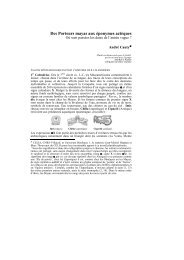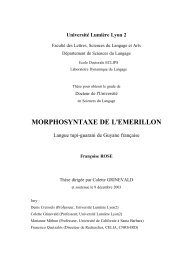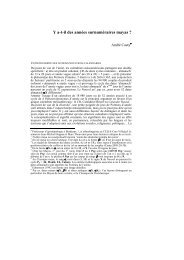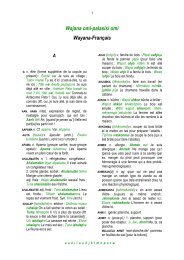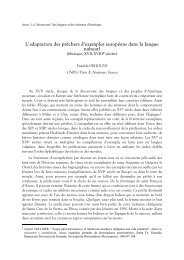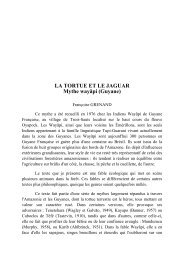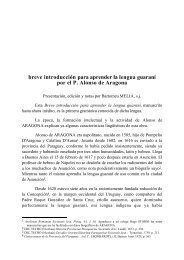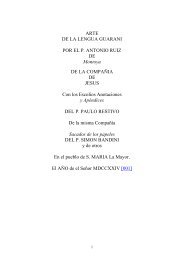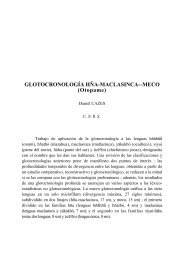The Blue Bird of Ergativity - celia
The Blue Bird of Ergativity - celia
The Blue Bird of Ergativity - celia
You also want an ePaper? Increase the reach of your titles
YUMPU automatically turns print PDFs into web optimized ePapers that Google loves.
"ergativity" is analogous to an effort to collect, say, birds with talons -- animportant taxonomic criterion --, birds that swim -- which is taxonomically onlymarginally relevant, but a very significant functional pattern --, or, say, birds thatare blue, which will turn out to be pretty much a useless criterion for any biologicalpurpose.I would expect, for example, that a series <strong>of</strong> workshops on something like"subject" in Amazonian -- or Northwest North American, or South Asian, or whathave you -- languages would be very likely to have theoretically interesting results.But if I think about what might result from a workshop on "ergativity" in NorthwestNorth America, I suspect that we would end up with a kind <strong>of</strong> a natural historyexhibit, with various strange and exotic specimens on display, but no systematicresult issuing from it all. Now a workshop on ergativity in north India would bequite productive -- but that is because all the languages involved are geneticallyrelated and have some variant on the same kind <strong>of</strong> "ergativity", with the sameorigins. A workshop on ergativity in Himalayan languages might be <strong>of</strong> interest, butwhat we would find is several different patterns, with overlapping origins, eachreplicated with different variations in different languages. But what might come out<strong>of</strong> such a workshop would not be anything that could be usefully integrated withthe outcome <strong>of</strong> the North Indian workshop, and might or might not show somepatterns in common with what turned up in North America.What do we mean by ergativity?Dixon provides a version <strong>of</strong> the standard definition <strong>of</strong> "ergativity":a grammatical pattern in which the subject <strong>of</strong> an intransitive clause is treated in the sameway as the object <strong>of</strong> a transitive clause, and differently from transitive subject. (Dixon1994:1)which we might schematize as S = O ≠ A. Now, to start with, this phrasing is a bitout <strong>of</strong> touch with ordinary usage. <strong>Ergativity</strong> is generally talked <strong>of</strong> as being aboutmarking, or marked treatment, <strong>of</strong> the transitive subject, not about the "treatment" <strong>of</strong>the intransitive subject. But, leaving aside the question <strong>of</strong> phrasing, the definition isstill problematic. If this were actually the definition which we used, it might bemore useful than the "ordinary language" use (or might not, that is an empiricalquestion). But, although this definition is still <strong>of</strong>ten cited, I do not think anyonewould seriously hold to it in dealing with data like these, from Tibetan:1) kho-s blo=bzang-la gzhus-songhe-ERG Lobsang-LOC hit-PERFHe hit Lobsang.'2



